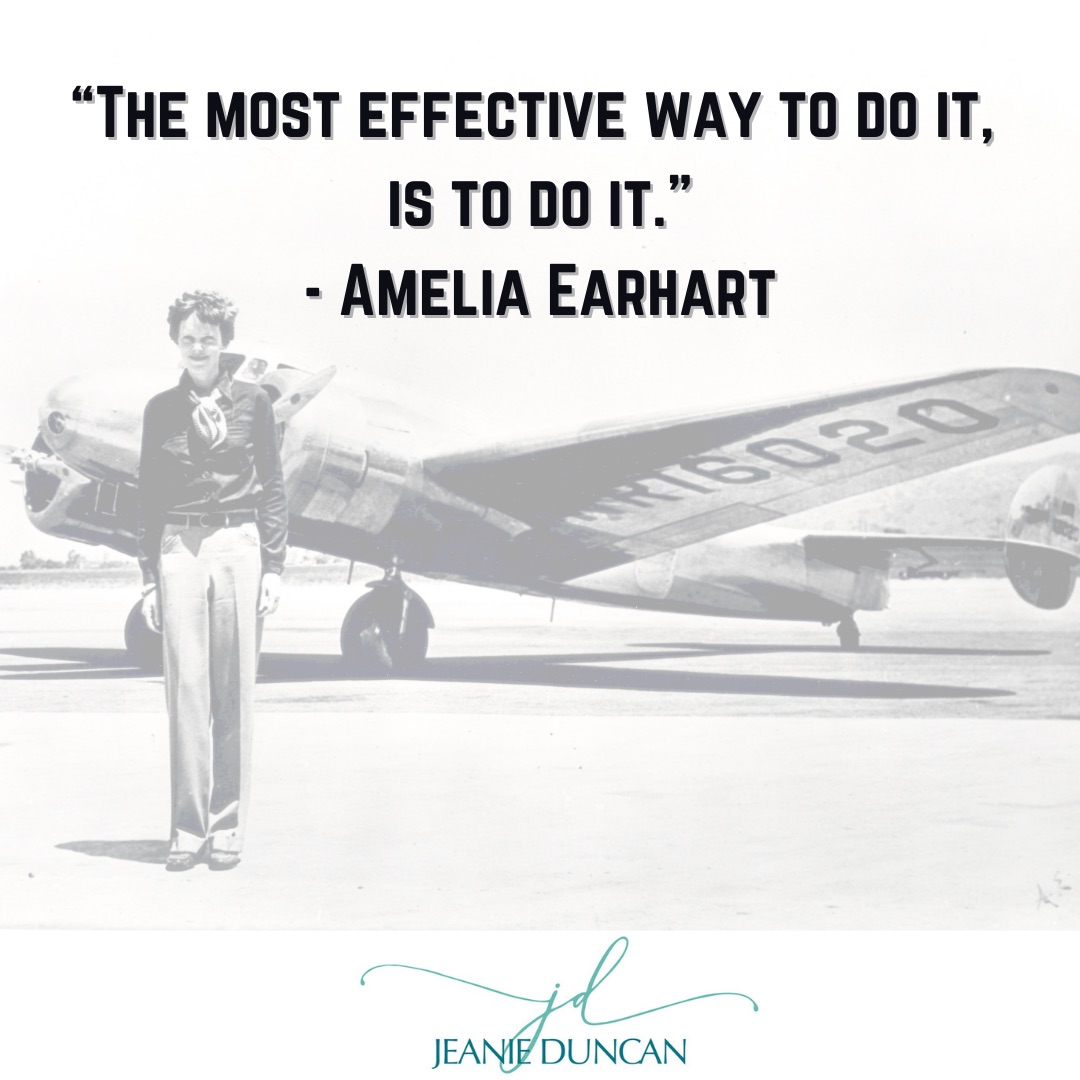
Jan 5, 2021 | Action, Focus, Intention, Strategy

For my 2021 intention setting, I’ve picked this Amelia Earhart quote and two words as my guideposts: Immerse + Commit.
I love variety – a lot of things, options, choices. If I were to describe my life as a buffet line, when I reach the end, my plate would be piled high and about to break under the mountain of food – everything looked so good, so I took just a little bit…and then the little became a LOT.
This lived experience can have me setting too many goals, taking on too many clients and projects, and casting a net too wide because it all looks so delicious!
My “way,” while exciting and filled with variety, often keeps me from having the rich depth of experience I want to have. It also prevents me from truly committing to something and finishing or mastering it, because of the sheer heap of assortment.
So, for 2021 I’m immersing in and committing to a small “salad plate” of:
- Writing
- Coaching
- Work in equity, inclusion and diversity
- My overall health and wellness
And my shero, Amelia, with her “the most effective way to do it, is to do it” will guide me through!
2021 Planning Guide
Here are a few prompts that support my clients with intention and priority setting. I hope you find them helpful to do your own 2021 reflection.
- Identify up to 3 items that you want as your MAIN areas of focus for the year. For each area, provide a simple heading (written in first person) that states what you want to have achieved by December 31. Underneath each, note one or more measurable outcomes you will see/experience as a result.
- For these areas of focus, what do you anticipate that might hold you back or get in your way? Listing these can help you be prepared for potential barriers and to prevent them before they arise.
- What theme (or themes) encapsulates the above areas of focus?
- Of the theme(s) you’ve listed, what word or two best captures the essence?
- Identify a quote that can serve as a “headline” or “billboard” for you, related to your key words. (Searching quotes based on your key words or themes is helpful.)
It’s a good idea to post your results to this “worksheet’ in a place where you’ll see it every day. I have mine on my office wall and placed as a “bookmark” in my daily writing journal. Cheers!
 Hi, I’m Jeanie Duncan. I work with individuals and organizations as a transformation partner to help them unlock their Truth, discover authentic value, and create meaningful impact in the world. I believe when we are truly aligned with our purpose, we can live and perform at our highest potential. With over 25 years of experience as an executive, CEO, consultant, coach, and writer, I offer strategic, knowledgeable, and experienced guidance for those who are ready to take the courageous leap toward true transformation.
Hi, I’m Jeanie Duncan. I work with individuals and organizations as a transformation partner to help them unlock their Truth, discover authentic value, and create meaningful impact in the world. I believe when we are truly aligned with our purpose, we can live and perform at our highest potential. With over 25 years of experience as an executive, CEO, consultant, coach, and writer, I offer strategic, knowledgeable, and experienced guidance for those who are ready to take the courageous leap toward true transformation.

Feb 23, 2015 | Leadership

The foundation of any highly functioning team is trust. While critically important, it can be rare among teams, and we all know it takes time and intentional practice to build. Trust is all about vulnerability – get comfortable being open, honest, and ‘exposed’ to one another around failures, challenges, and areas for development and trust begins to emerge. The process is well worth the effort invested and can be cultivated with sustained intention, purpose, and focus.
In many workplaces, what we find is a group of individuals who have been hired over time and are expected to begin working together without any prior relationships or baseline of trust being formed. They may even call themselves a team, but in reality, they’re individual performers charged with accomplishing a group goal. This is very different from a “team.” And it’s not a formula for success, especially in light of challenges and potential conflict inherent to any project or task.
Try these trust-building exercises to help develop a strong, highly functioning team:
- In his book “Overcoming the Five Dysfunctions of a Team,” Patrick Lencioni shares the Personal Histories Exercise. It works like this: At a staff meeting, go around the room and have each person respond to a question (or questions) that requires them to share something personal and relevant. For example, the author offers this three-part question: 1) Where they grew up, 2) How many kids were in the family, and 3) What was the most difficult or important challenge of their childhood. In responding, the group learns a lot about one another, and in the process, they become more comfortable being open about other things. Empathy develops, and it also helps individuals overcome what Lencioni calls the fundamental attribution error, where we tend to falsely attribute the negative behaviors of others to their character (false conclusion: people do bad things because they’re bad).
- Administer a behavioral assessment with a team – a tool that will provide an objective, reliable means for understanding and describing one another. There are many from which to select – Meyer’s Briggs, DISC, Strengths Deployment Inventory, to name a few – and each can be an effective means to self-identify their ‘type’ and provide a common vocabulary to describe similarities and differences. Such a tool can be completed with a team in as little as a couple of hours or extended to a half- or full-day experience.
- Another proven way for a team to learn to work together to build trust is to attend a high initiative or ropes course. This experience typically takes at least a half-day and is offered to teams by independent training organizations. Hanging at the end of each other’s rope is a great way to increase risk taking and trust levels, using an ultra safe and highly supervised course.
Key to making any of these exercises work is to anticipate initial objections and have proper facilitation. These experiences, when implemented well, can establish a foundation of team trust and set a path for achieving great results together.
_______
Lencioni, P. (2005). Overcoming the five dysfunctions of a team: a field guide. San Francisco: Jossey-Bass.
Also read these related blog posts:
Perspectives on Conflict with Your Boss
Bridge the Divide of Conflict with Direct Reports
Into the Storm: Mastering Team Conflict
A Process for Managing Peer Conflict
 About Jeanie Duncan: Jeanie is President of Raven Consulting Group, a business she founded that focuses on organizational change and leadership development in the nonprofit sector. She is a senior consultant for Raffa, a national firm working with nonprofit clients to lead efforts in sustainability and succession planning, executive transition and search. Additionally, Jeanie serves as adjunct faculty for the Center for Creative Leadership, a top-ranked, global provider of executive leadership education.
About Jeanie Duncan: Jeanie is President of Raven Consulting Group, a business she founded that focuses on organizational change and leadership development in the nonprofit sector. She is a senior consultant for Raffa, a national firm working with nonprofit clients to lead efforts in sustainability and succession planning, executive transition and search. Additionally, Jeanie serves as adjunct faculty for the Center for Creative Leadership, a top-ranked, global provider of executive leadership education.

Jan 22, 2015 | Focus
It topped 50 degrees last Sunday…almost enough to give me some early spring fever in January. I decided to curl up in my window seat, enjoy the warm sunshine, and savor a thought provoking read, “The Power of Less” by Leo Babauta. In keeping with his mantra, the book is brief enough to finish in an afternoon. Bonus!
Just three days later, I can’t stop thinking about his core principles. I find them so meaningful and effective that I’d like to highlight a few. I’m especially enjoying the one “simple focus.” What a difference I’m experiencing with only a few days of intentional practice. I hope you’ll give them a try too!

Set Limits
We live in a world where we’re overwhelmed with ‘stuff.’ Our homes are filled with too many things. Our days are packed with an unending string of meetings and tasks. The inbox overflows with dozens of emails. We have too much – clutter, information, tasks, and choices. It simply won’t all fit.
With a ‘less is more’ framework, Babauta encourages a life with limits. “Setting limits simplifies things, focuses our energy, highlights the important, and makes us more effective.” It’s as if time and space expand.
This week, I’m paying more attention to when and where I feel the overload and need for cutting back. I’ve turned off the distracting visual email prompts, assessed meeting invitations with a new lens and declined more than typical, and reduced the number of blogs and listserves to which I subscribe. Already, it feels freeing.
Choose the Essential and Simplify
Choosing the essential is the key to simplifying – you have to choose the essential before you simplify, or you risk eliminating things without keeping the most important. “Simplifying isn’t meant to leave your life empty – it’s meant to leave space for what you really want to do.”
For me, getting to the essential starts with eliminating the non-essential – like the quote from sculptor Michelangelo, “I saw the angel in the marble and carved until I set him free.”
However you get there, once you know what’s essential, you reduce projects, tasks, commitments, and clutter. In my work with my executive coaching clients, an important part of the process is for a client to know his/her core values, set goals, and confirm what’s most important and brings you the greatest joy.
Simple Focus
 The “Power of Less” presents focus as the most important and powerful tool – “focus on less to become more effective.” Intellectually, I get it, but practice it is far more difficult. Here’s what helps me most:
The “Power of Less” presents focus as the most important and powerful tool – “focus on less to become more effective.” Intellectually, I get it, but practice it is far more difficult. Here’s what helps me most:
- Identify the most important priorities (and tasks).
- Keep these front and center. I do this by creating an annual plan, then breaking that down by quarter, month, week, and day.
- Begin each day by focusing on the most important tasks, executing these one at a time until complete.
- Resist checking email and exploring the internet first thing in the day, otherwise I become occupied by urgent or intriguing distractions.
- Focus on the present instead of the past or future. This is so challenging! I compare it to attempting to quiet my mind during meditation. It helps to practice with the simple things in my day – eating, driving, sleeping – focusing only on that, and enjoying it. When I can do that, it feels like pure flow.
Start Small
Send your overachiever to time out! Starting small is simply a way to ensure the greatest likelihood of success for all the other changes.
Think of the fail rate with New Year’s resolutions: we start the year excited and rearing to go. Like a Thoroughbred out of the gate, we charge forward – make the first lap and maybe a second, and then start to lose steam or quit altogether. The value of setting realistic, achievable goals is important to have any chance of success.
This reminds me of when I began running. My son was in the 4th grade at the time and asked me to run with him to prepare for his school’s 1-mile event. For a week or two, we practiced together, and he accomplished his goal. Next, we decided to sign up for a local 5K. We completed it, and by then I began to enjoy running.
For the next year, I ran several community 5K events. I decided to step it up and run 10Ks the next year. Then, in year three, I trained for and ran my first half marathon. Now, eight years later, I’ve completed about ten half marathons. Starting small was key to my running success and sustainability.
Declutter
This principle begins with “A clean desk allows you to focus on the task at hand, which is key to being effective in whatever you’re trying to do.” So today, in honor of this idea, I cleaned up my office and desk. Maybe it’s just in my head, but afterward I swear I was able to think more clearly and accomplish more.
Another way I’ve practiced this principal recently is conducting a home inventory and identifying things we no longer use. We’ve made countless trips to our local Goodwill, learned how to “do eBay,” and have experienced good success in selling many items. It’s inspired us to set new goals geared toward decluttering and downsizing, like:
- Set aside time to clean out.
- Start simple – with one room, a closet, or a drawer
- Handle paperwork only once, taking immediate action (like paying a bill), filing, or tossing it.
- Have a home for everything and keep things in their place.
- For every item you bring into your home, remove something of equal size and significance.
Slow Down
Years ago, I decided to take a sabbatical for a few months. One of the first things I experienced was a much slower pace. I stepped off the frantic work treadmill, engaged in some creative pursuits, and savored the foreign white space on my calendar. My friends worried that the change was so abrupt, I would need therapy. Not the case!
Before this “time out,” my life was jam-packed. I never completed a task list, rushed everywhere I went, and felt behind, late, and exhausted. I had enthusiastically signed up for this career and professional leadership role, but I didn’t want to live my life like this.
As Babauta states in his book, “We were not made to function this way…the stresses of constant overload and a constant hectic pace for every waking moment.” The paradox is to slow down to be happier, more effective, and productive.
During my time off, I consciously slowed down. I ate slower, walked slower, drove slower. Here’s a novel idea: when you eat, just eat. Enjoy it. Savor it. Truly taste it. Try the same for driving: appreciate the complete experience of driving and notice what’s around you. Do you ever arrive at a destination and have no recollection of how you got there? My goal then and still today is to shift away from that and be fully present with whatever I’m doing. I probably fail more than I succeed, but this book is a great reminder to re-focus.
 About Jeanie Duncan: Jeanie is President of Raven Consulting Group, a business she founded that focuses on organizational change and leadership development in the nonprofit sector. She is a senior consultant for Raffa, a national firm working with nonprofit clients to lead efforts in sustainability and succession planning, executive transition and search. Additionally, Jeanie serves as adjunct faculty for the Center for Creative Leadership, a top-ranked, global provider of executive leadership education.
About Jeanie Duncan: Jeanie is President of Raven Consulting Group, a business she founded that focuses on organizational change and leadership development in the nonprofit sector. She is a senior consultant for Raffa, a national firm working with nonprofit clients to lead efforts in sustainability and succession planning, executive transition and search. Additionally, Jeanie serves as adjunct faculty for the Center for Creative Leadership, a top-ranked, global provider of executive leadership education.

Jul 29, 2014 | Strategy
I’m struggling with my ability to focus today. As in – ‘there are so many priorities, and they all seem like they’re #1.’ Ever experience this challenge?
 When I find myself in this place, the best thing I can do is sort the priorities. If they’re all #1, I find a way to divide them 1A, 1B, 1C. Even when I think they’re the same level of priority and urgency, this helps me differentiate to some degree. This way, I take the 20-headed beast down to 5 heads, focusing now on the top 5 things I must accomplish – in an hour, a day, or a week. Yes, the other 15 things are important too, but they’ll have to take 2nd place for now. Because if there are 20 priorities at once, I know what will happen – I become paralyzed and do nothing, or I fall into a spin and do a little bit with all the items and get little accomplished. In the most busy and pressing times, I do this exercise each day or even twice a day.
When I find myself in this place, the best thing I can do is sort the priorities. If they’re all #1, I find a way to divide them 1A, 1B, 1C. Even when I think they’re the same level of priority and urgency, this helps me differentiate to some degree. This way, I take the 20-headed beast down to 5 heads, focusing now on the top 5 things I must accomplish – in an hour, a day, or a week. Yes, the other 15 things are important too, but they’ll have to take 2nd place for now. Because if there are 20 priorities at once, I know what will happen – I become paralyzed and do nothing, or I fall into a spin and do a little bit with all the items and get little accomplished. In the most busy and pressing times, I do this exercise each day or even twice a day.
This place of ‘everything is a priority’ leads us into the trap of pressing harder, faster, and with greater intensity to try and accomplish everything or achieve a particular unrealistic goal or deadline.
I somehow trick myself into thinking that working harder and doing more is what’s needed to get the job done. Intellectually, I can rationalize the truth in this. But, at a deeper level, I realize that intense effort and pace often depletes my energy, can adversely impact my output, and removes the joy from my work.
To help combat this tendency, I have adopted some practices I find beneficial and that have helped me most:
- Spend the first hour of the day setting priorities and getting organized. It’s easy to launch into the day reacting to the urgent – the rain of emails, interruptions from co-workers, and the barrage of phone calls – rather than advancing the important. I like to get an early start to the day and establish priorities. I begin with the question: “What are the three most important things I need to accomplish today to advance my key goals?” Everything else is a “nice to have.” These three daily priorities all roll up to support my weekly, monthly, and quarterly goals.
- Focus on the important tasks first. Once I frame my day in the first hour, I immediately set out to accomplish the top three priorities before distractions have a chance to pull me away. If I can’t take care of them all, I’ll make an appointment on my calendar to return to it later in the day.
- Single-Task. When I’m doing too much, I’m constantly switching from one task to another, experiencing multiple interruptions and distractions. Despite our culture’s demand to multi-task, resist the temptation, clear away distractions, and give attention to the single matter that is most important.
- Eliminate non-essential commitments. Examine your day or week and ask yourself: “What can I eliminate or delegate? Is that task, meeting, or luncheon something that I absolutely must do? How does it advance my strategic goals?” I try and say no to any request that distracts me from focusing on what’s most important. I think of it as focusing on my highest and best use.
- Step away and take a break. We all have those occasions when work calls for added effort. But more often than not, simply stepping away and taking a break – like going for a run or having lunch in a park – can infuse new energy, bring fresh perspective and new ideas, and actually enhance productivity.
- Ask key questions. Another tactic I find helpful is pausing to ask a few critical questions to help me determine priorities or my approach as I begin a particular project or task. It’s an important skill for anyone focused on improving performance, and it can help filter through all the distractions and get to the one thing that will deliver the result. For example:
- How important is this?
- What do I want?
- Why?
- How will I know when I achieve it?
- What can I do to achieve that outcome?
- What can I learn from others who have gone before me?
- What do I bring from prior experiences that can help inform my present situation?
Challenge yourself this week to do less, focus on what’s most important and will deliver the greatest impact, and discover deeper meaning and success in your work. Notice what happens!
“Don’t mistake activity with achievement.” ~ John Wooden
Jeanie is President of Raven Consulting Group, a business she founded that focuses on organizational change and leadership development in the nonprofit sector. She is a senior consultant for Raffa PC (formerly TransitionGuides), a national firm working with nonprofit clients to lead efforts in sustainability and succession planning, executive transition and search. Additionally, Jeanie serves as adjunct faculty for the Center for Creative Leadership, a top-ranked, global provider of executive leadership education.
photo credit: modenadude via photopin cc

Mar 25, 2014 | Intention, Leadership

A few years ago while conducting research around starting my own business, I ran across a book I really enjoyed called “Birthing the Elephant” by Karin Abarbanel and Bruce Freeman. From it, came a favorite quote of mine: “Act as if.”
Presented in the context of being an entrepreneur, the short phrase expresses the concept of viewing yourself in a new way and aligning your actions and the way you communicate to reflect this new ‘brand’ and self image. “Actions change attitudes, motions change emotions, and movements change moods. You might not be able to change your thoughts and your feelings, but you can change your actions. Your actions can change your feelings; your actions can change your thoughts. You can act differently than you feel.”
The day I read page 121 and the words “act as if” is the day I decided to begin my business. For several months, I had conducted research around launching a new venture, secured necessary resources, and written a business plan. On paper, it looked great, and when I read the words “act as if,” I thought “what am I waiting for?” It’s interesting when you’re starting something from scratch. There’s a moment when you literally must flip the switch. So I did.
The quote “act as if” hit home for me. In that moment, I took on the mantle of entrepreneur and business owner – I walked as if, ate as if, slept as if…I went about my day as if this is completely who I am, even though early on there were many days where it felt more like a story than reality. I lived this new brand as if everything in my life up to this moment had prepared me for this.
It’s three years later and – through much hard work and many challenges, along with steady progress and great wins – my business is flourishing.
Today, in my coaching and consulting practice, I encourage individuals, teams, and organizations to “act as if” with their vision, mission, and plan. I encourage people and organizations to dream and imagine their most vibrant future. And with that, I challenge them to act as if they’re already there. After all, our thoughts and actions create our reality. We manifest what we most desire and focus on.
My hope is that this mantra will inspire my clients and those I serve as much as it has me. And that they will overcome the one thing that holds most of us back: the belief that we must wait until we know who we are or until we craft the perfect plan before we even get started. Just remember, you’re more ready than you think you are. Get started now.
Act as if what you do makes a difference. It does.
~ William James


 Hi, I’m Jeanie Duncan. I work with individuals and organizations as a transformation partner to help them unlock their Truth, discover authentic value, and create meaningful impact in the world. I believe when we are truly aligned with our purpose, we can live and perform at our highest potential. With over 25 years of experience as an executive, CEO, consultant, coach, and writer, I offer strategic, knowledgeable, and experienced guidance for those who are ready to take the courageous leap toward true transformation.
Hi, I’m Jeanie Duncan. I work with individuals and organizations as a transformation partner to help them unlock their Truth, discover authentic value, and create meaningful impact in the world. I believe when we are truly aligned with our purpose, we can live and perform at our highest potential. With over 25 years of experience as an executive, CEO, consultant, coach, and writer, I offer strategic, knowledgeable, and experienced guidance for those who are ready to take the courageous leap toward true transformation. 










Recent Comments